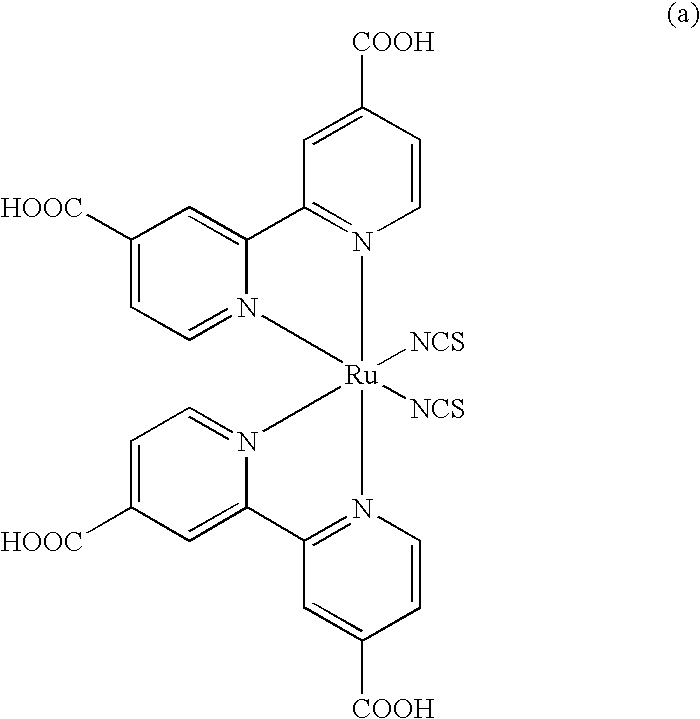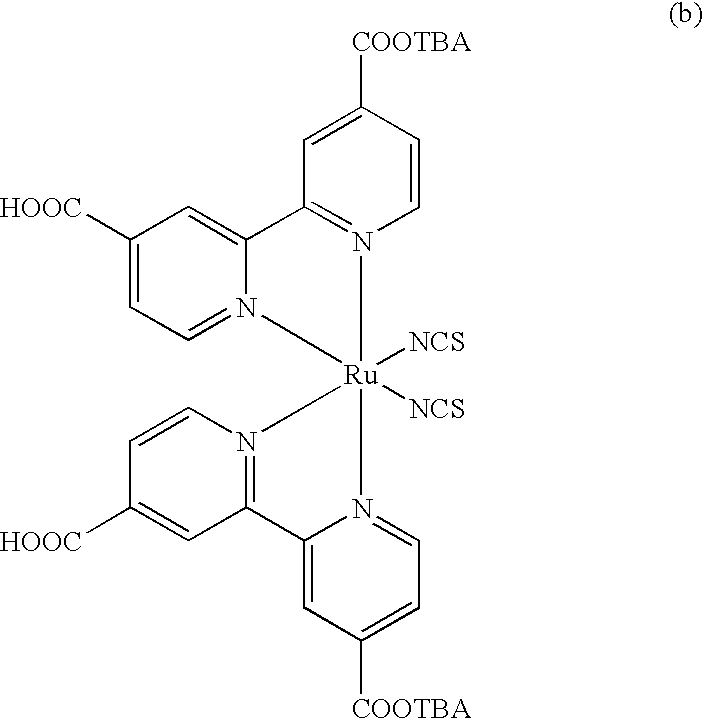Dye compound
- Summary
- Abstract
- Description
- Claims
- Application Information
AI Technical Summary
Benefits of technology
Problems solved by technology
Method used
Image
Examples
example 1
Synthesis of 4-(1-methyl-1H-pyrrole-2-yl)-N,N-diphenylaniline)(12)
[0098]Under nitrogen atmosphere, 3.24 parts of 4-bromo-N,N-diphenyl-aniline (11), 4.00 parts of 1-methyl-2-(tributylstannyl)-1H-pyrrole which was synthesized according to the method illustrated in Armaroli, N.; Balzani, V. Angew. Chem. Int. Ed. 2007, 46, 52, and 0.07 parts of PdCl2(PPh3)2 were added into dry dimethyl formamide under stirring to obtain a mixture. Then, the mixture was heated to 100° C. and reacted for 16 hours. After the mixture was cooled, a KF aqueous solution was used to stop the reaction. The mixture was extracted by diethyl ether, washed with a concentrated salt solution, and then dehydrated by magnesium sulfate. After removing the solvent, a product was purified by dichloromethane / hexane in a silica gel column to obtain the compound (12) of the present example.
example 2
Synthesis of 4-(5-(4-(diphenylamino)phenyl)-1-methyl-1H-pyrrol-2-yl)-benzaldehyde (14a)
[0099]The compound of the present example was synthesized by the same method as described in example 1, except that 1.85 parts of 4-bromo-benzaldehyde was used to substitute 4-bromo-N,N-diphenylaniline, and 6.63 parts of 4-(1-methyl-5-(tributylstannyl)-1H-pyrrole-2-yl)-N,N-diphenylaniline (13) was used to substitute 1-methyl-2-(tributylstannyl)-1H-pyrrole, wherein 4-(1-methyl-5-(tributylstannyl)-1H-pyrrole-2-yl)-N,N-diphenylaniline (13) was synthesized according to the method illustrated in Armaroli, N.; Balzani, V. Angew. Chem. Int. Ed. 2007, 46, 52.
example 3
Synthesis of (E)-2-cyano-3-[4-(5-(4-(diphenylamino)phenyl)-1-methyl-1H-pyrrol-2-yl)]phenyl)acrylic acid (15a)
[0100]0.80 parts of 4-(5-(4-(diphenylamino)phenyl)-1-methyl-1H-pyrrol-2-yl)benzaldehyde (14a), 0.21 parts of cyanoacetic acid, and 0.04 parts of ammonium acetate was added into 10 parts of acetic acid under stirring to obtain a mixture. Then, the mixture was heated to 120° C. and reacted for 8 hours. After the mixture was cooled to 25° C., the resultant solid was taken out. The resultant solid was washed by water, diethyl ether, and methanol sequentially to obtain a dark brown solid. Finally, the dark brown solid was purified in a silica gel column to obtain the compound (15a) of the present example.
PUM
 Login to View More
Login to View More Abstract
Description
Claims
Application Information
 Login to View More
Login to View More - R&D
- Intellectual Property
- Life Sciences
- Materials
- Tech Scout
- Unparalleled Data Quality
- Higher Quality Content
- 60% Fewer Hallucinations
Browse by: Latest US Patents, China's latest patents, Technical Efficacy Thesaurus, Application Domain, Technology Topic, Popular Technical Reports.
© 2025 PatSnap. All rights reserved.Legal|Privacy policy|Modern Slavery Act Transparency Statement|Sitemap|About US| Contact US: help@patsnap.com



